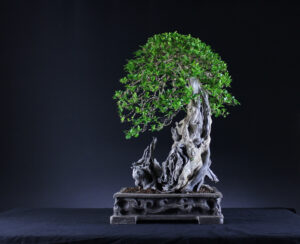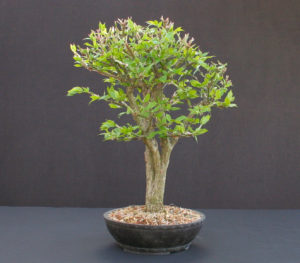/
Every Spring and Fall people will purchase bare root trees to plant and use either in their gardens or as bonsai. Bare root trees are cheaper to purchase usually because the shipping costs are cheaper since no soil is shipped with them.
So the question has come up time and again on how to care for bare root trees. Due to the fact the trees have no soil around their roots, this means they need some special attention when they are received. You cannot control shipping conditions between you and the supplier. However after that, you can control how they are handled once they arrive. Here are some tips for ensuring your trees arrive in good shape:
1) Order from a reputable dealer. Reputable dealers will ship their trees not long after bare rooting them, and will take the extra precautions to make sure your trees are disease and pest free before they are shipped. They will also package the trees in such a way that the roots stay damp and don’t dry out. Avoid buying bare root trees off places like Ebay, you don’t know how long those trees have been laying around. Avoid buying from companies that do not list the approximate size of the trees they are shipping. A company that I use lists not only the approximate size range but also the approximate age of the saplings they are shipping you. This way you have an idea of what you are getting. I get catalogs regularly in the mail for trees and some don’t list the size, much less the age of the saplings they are sending you. It’s nice to know if you are getting a three year old sapling versus a one year seedling, or a three foot tall tree versus a six inch tall sprout.
2) Know the approximate day they will arrive so you can arrange to either be there to receive the package, have someone else recieve the package for you, or leave a note for your friendly delivery person where you want the package left. If you do leave a note, a shady spot under a tree is preferable to the hot asphalt of your driveway. Bare root trees cook on a driveway. If it’s quite cold outside, make sure the spot for the package is out of the wind and sheltered from most of the weather ( Porch, partly covered deck, settled behind a bush near the door…)
3) Be sure to have all your various soil components, pots, and other needed items already purchased and ready to go so when the trees arrive you can begin your planting adventure and your trees won’t be without soil for an even longer period of time. It’s best to plant your trees the same day they arrive.Alright so you have those trees in hand, they look healthy, and you’re ready to plant.
Now what? Here’s what to do next:
1) Carefully remove the trees from the package. Inspect the roots. Gently prune away any damaged or diseased roots. Leave everything else intact. Yes, this means leave the tap root intact too. Why? In my experience with bare root trees, doing any extensive root pruning either slowed the growth immensely or the tree just did not thrive and eventually died, or never grew at all. Leave the root pruning for after the tree has had a year or two to recuperate. A tip here to keep in mind is that bare root trees tend to do better if purchased and planted in the Spring. In the Spring, trees are gearing up for growth, and can therefore recover better from the stress of being bare rooted and shipped. While I have certainly planted bare root trees in the Fall, I have found a greater success rate with those planted in the Spring.
2) Pre-planting Care. Here is where some bonsai enthusiasts and tree-lovers differ. Never soak the tree for hours and hours and days on end, you’ll kill the poor things by drowning them. However, a gentle soak for the five to ten minutes it takes to mix up your soil is fine. Don’t soak the trees for more than a couple hours. Now some people will add things to the soaking water. It could be things such as Superthrive, Vitamin B1, root stimulating products, very diluted seaweed/kelp fertilizer, or even diluted fish emulsion. Some use nothing at all in the water. Shultz’s has out a product for transplants that contains B Vitamins and this is what I use. It’s like a third of the cost of expensive Superthrive. What one would pay for four fluid ouces of Superthrive, gives you two full liters of the Shultz’s stuff. My advice here is to simply use what works for you. (No matter what you use, always be sure to read the directions on the labels first before use!) There are also those people who plant the trees directly into the soil without any soaking time. Again, do what works for you in your climate area, or what gives you the best results. This is also an ideal time according to Harry Harrington to apply a tourniquet to do a ground layer if the root spread needs work so that you can develop a nice nebari. (If you are new to bonsai, please learn about air layering, ground layering and other advanced techniques by reading up on them before trying them on trees. Leave doing such things as tourniquets for when you are more knowledgeable.)
3) Plant the tree into your soil you have just mixed. One thing to note, especially for those just getting their first trees who may have no prior experience with trees. Never plant the tree so deep that you are burying a portion of the trunk in the soil. The bark of a tree planted down in the soil can rot, attract fungus and pests. It’s just not a good scenario. Plant the tree just deep enough that all the roots are covered in soil up to the base of the trunk.
4) Once your tree is planted, water it well. I use the exact same water I did the presoak with and water them with that. Take the well watered tree and place it in a sheltered spot out of the elements but where it can get sun and air outside, but won’t get frost. Check the tree for water regularly and water when the soil feels dry on top. As the tree starts to break bud, go ahead and give it some balanced fertilizer, or a fertilizer with a high phosphorus content to help with root growth. Always read the directions on the fertilizer, you don’t want to burn the roots!
If you are planting a bare root tree in the Fall: Skip the fertilizer for your tree is dormant and keep this tree in a sheltered spot for the winter, then move it out more into the open after the last frost has passed in the Spring. You can store them with your other outdoor trees for the winter, either mulched in or in an unheated garage or shed too. Just be sure to give your tree water during the winter too. Even though a dormant tree appears to not need water, it still needs some, just not as much as during the growing season.You now have a wonderful tree in a pot, it’s leafed out, and growing. What next? Well depending on it’s vigor, you could start formative pruning as long as the tree is growing vigorously and shows no outward signs of stress.
However, I have found that giving the tree a full growing season of no pruning is the best way to go. Depending on the species, even two years of growth is best. Just fertilize the tree every couple weeks along with your other trees you may already own. Once the tree is established after a year or two of growth, full work can begin.
A note on tree health: So you don’t know what a healthy tree may look like? Take a peek at what you have in your hand. An unhealthy tree will possibly show signs of disease such as fungus on the bark, dead branches without bark, bark missing on portions of the tree, blackened slimy roots, or strange shaped/colored formations on the roots that are not normal for the species.
A healthy tree will have good roots with no signs of disease or rot, and will have it’s bark intact. If you get ahold of trees from a supplier that are unhealthy, contact the supplier about replacements.




